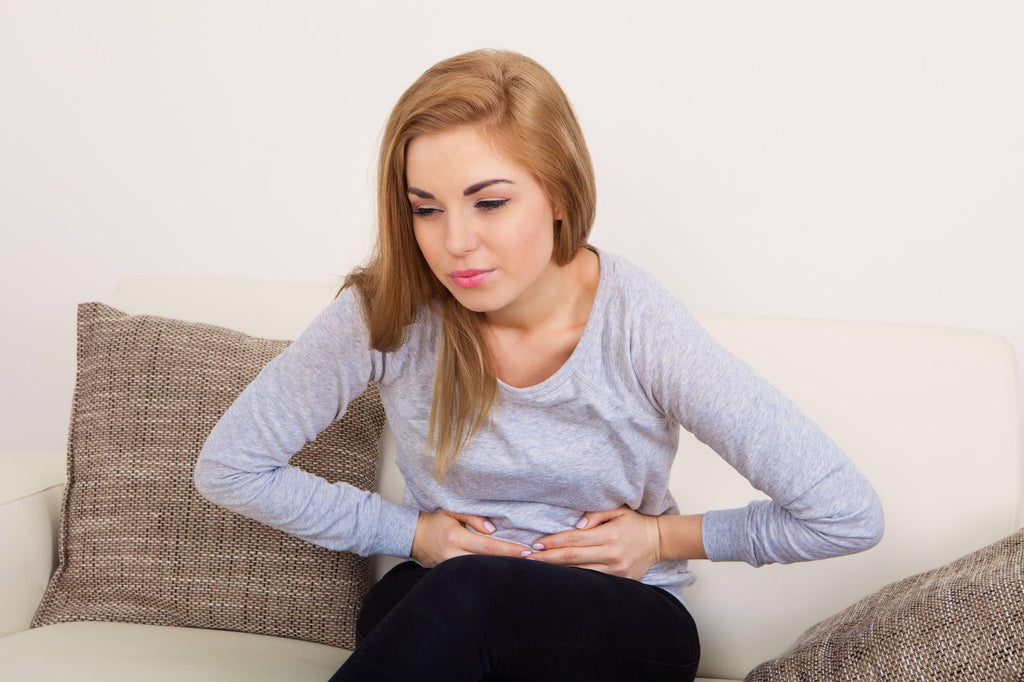I think it’s safe to say that most women (yours truly included) have experienced at least some degree of menstrual cramps in their lives, which can range from mild discomfort to serious pain.
But one out of five women suffers from extremely severe pain to the point where it is debilitating, otherwise known as dysmenorrhea.
In addition to the pain, symptoms of dysmenorrhea can include nausea, vomiting, diarrhea, irritability, weakness and even fainting spells!
Here are some of the underlying factors behind this painful condition, as well as safe, natural ways to get relief.
Two types of misery
There are two types of dysmenorrhea—primary and secondary.
Secondary dysmenorrhea can be the result of a number of different gynecological problems.
Things like endometriosis, uterine fibroids, pelvic inflammatory disease (PID) or complications from an IUD insertion can all cause or worsen painful menses.
Primary dysmenorrhea is more of a stand-alone condition—it’s having painful periods that are not related to another specific sickness or condition. The pain is typically caused by uterine muscle contractions that occur in order to assist in shedding of the uterine lining.
Primary dysmenorrhea can be broken down into two categories—congestive or spasmodic.
Congestive dysmenorrhea is typically characterized by a dull aching pain in the pelvic region for the one or two days prior to menstruation, and usually subsides once menstruation starts.
Spasmodic dysmenorrhea causes vise-like cramping of the uterine muscles. They usually begin at the onset of menses and continue for four to six hours or more.
Here is a list of ALL the symptoms of the two categories of primary dysmenorrhea—see how many sound familiar to you:
| Congestive dysmenorrhea | Spasmodic dysmenorrhea |
| Dull, aching pain | Sharp, vise-like cramps |
| Lower back pain and tender pelvic region | Gripping pains in lower abdomen |
| Bloating | Sharp pains shooting to inner thighs or low back |
| Weight gain | Fatigue |
| Tender breasts | Faintness to the point of passing out |
| Headaches or migraines | Hot and cold flushes |
| Irritability | Nausea and vomiting |
| Worsens with age, especially in the 30s and 40s | Diarrhea, constipation, bowel urgency |
| Headaches |
Prostaglandins—the primary instigator
One of the primary instigators behind dysmenorrhea is a culprit called “prostaglandins.”
Prostaglandins are hormone-like substances. They function as messengers in many of your body’s activities and physiological responses including inflammation, muscle contraction, blood clotting, dilation of your blood vessels and your immune system functioning.
When they’re working like they should, prostaglandins (PGs) are vital to gynecological health. A balance of PGs is necessary for normal menstruation to take place.
But dysmenorrhea occurs when there is a tsunami-like release of these inflammatory prostaglandins just before the onset of your period.
In addition, the inflammatory PGs can seep out of the uterus, get absorbed into circulation and trigger symptoms beyond abdominal cramps. This explains why dysmenorrhea can have such a wide variety of symptoms like I listed above.
And although the inflammatory PGs typically get destroyed quickly once they reach the bloodstream, often they have enough time to cause their harm before their demise.
It’s not a mystery
This cascade of inflammatory PGs might seem like a mystery to you, but it’s really not, especially when you understand how the different types of prostaglandins are created.
Prostaglandins are made from fatty acids that you take in with your diet, and the type of fat you eat largely determines the type of prostaglandin that is made.
Inflammatory prostaglandins are created from inflammatory-type fatty acids—specifically Omega-6 EFAs.
On the other hand, prostaglandins that decrease inflammation are derived from the natural anti-inflammatory Omega-3 EFAs.
NSAIDs to the rescue?
The typical medical treatment for dysmenorrhea is pain drugs, specifically NSAIDs like ibuprofen and naproxen.
Although they can be helpful, many women report that these drugs don’t work for them or lose their effectiveness over time. In those cases, many times women will take larger and larger doses, to the point where they can exceed safe dose levels!
And let’s not forget the potential side effects of NSAIDs including gastritis, leaky gut syndrome, liver damage and more.
Safe, natural and effective answers
The great news here is you can help ease the misery of dysmenorrhea in ways that are far safer than relying on NSAIDs and other drugs.
Here are 5 strategies that can help spell tremendous R-E-L-I-E-F for you:
1) Try acupuncture
Acupuncture has been extraordinarily helpful with pain of many types, and you can add dysmenorrhea on to the list!
2) Increase your intake of Omega-3 EFAs
As I mentioned earlier, Omega-3 EFAs are the building blocks for anti-inflammatory PGs, so it’s vital to make sure you have an adequate supply to help keep dysmenorrhea at bay.
Unfortunately, our typical diets are brimming with inflammation-causing Omega-6 EFAs and grossly deficient in Omega-3s.
That’s why supplementation with a fish oil formula like VitalMega-3 can be so helpful to so many people.
The daily 2-capsule dose of VitalMega-3 gives your body 1,200 mg of inflammation calming Omega-3 fatty acids, including 600 mg of EPA and 400 mg of DHA--the two all-important Omega-3 EFAs highly recommended by experts.
3) Have an anti-inflammatory diet
Concentrate on fresh vegetables, greens, and fruits, herbs and spices, wild-caught salmon and mackerel, nuts, and healthy fats like real butter, olive oil and avocado. Also, make sure you’re drinking at least 8 glasses of filtered water a day.
At the same time, avoid these highly inflammatory foods:
- Sugar in all forms
- Refined carbohydrates
- Vegetable oils
- MSG
- Factory farmed meats and fish
- Gluten
- Soy
- Soda
- Processed and fast foods
- Artificial sweeteners
4) Try essential oils
Sage essential oil (as found in our Adirondack Forest and Sage Blend) has been shown to help balance hormones naturally and has been found to effectively reduce pain and cramping when applied topically.
5) Supplement with Vitamin D
Current research has shown that supplementing with Vitamin D significantly decreases the severity of pain for women with primary dysmenorrhea.
This is yet another great reason to optimize your Vitamin D level with Optimum DK Formula with FruiteX-B.
Optimum DK provides a therapeutic 5,000 IU dose of Vitamin D3 in every capsule, along with its necessary partner Vitamin K, as well as the helpful mineral boron.
If you’ve been suffering with the misery of dysmenorrhea every month, it’s time for you to finally get some relief.
Take the bull by the horns and see just how great you can feel with the natural measures I’ve suggested above.
To your health,
Sherry Brescia











My ex-husband and I had always managed to stay friendly after our divorce in February 2017. But I always wanted to get back together with him, All it took was a visit to this spell casters website last December, because my dream was to start a new year with my husband, and live happily with him.. This spell caster requested a specific love spell for me and my husband, and I accepted it. And this powerful spell caster began to work his magic. And 48 hours after this spell caster worked for me, my husband called me back for us to be together again, and he was remorseful for all his wrong deeds. My spell is working because guess what: My “husband” is back and we are making preparations on how to go to court and withdraw our divorce papers ASAP. This is nothing short of a miracle. Thank you Dr Emu for your powerful spells. Words are not enough.
Email emutemple@gmail.com
Phone/WhatsApp +2347012841542.
My mother-in-law is having issues with her colon. I am sending her to your website. Her name is Shirley Ellithorpe.
Pity this information was not available when I was a lot younger! I used to take pain killers, and as you say, after a while they lose their effectiveness.